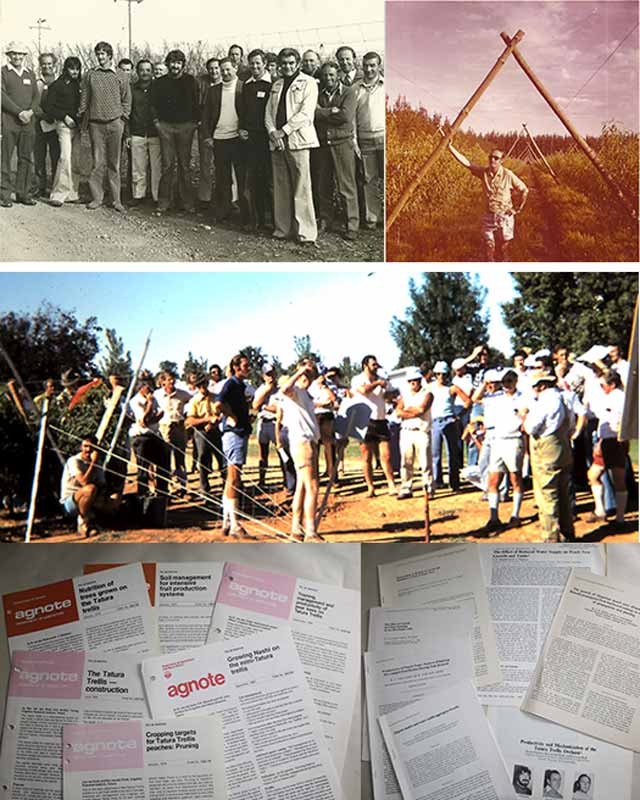Apply research findings to commercial orchard conditions: To encourage commercial adoption of the Tatura Trellis as a fully integrated system of orchard management, we did the following:
Scientific papers published in international horticulture and soil science journals, and conference presentations, were re-written for grower magazines, chapters in books, Technotes, DAV Research Reports and newspaper articles.
(Continued from last issue) A series of Departmental Agnotes were written by each researcher in their own field, as guides for those who wanted to adopt the Tatura system of growing fruit.
The Agnotes were part of a large extension model to reach orchardists, farmers and nurserymen.
•Field days, open days and demonstrations were organised to show the intricacies of the Tatura system of growing fruit.
Even classes of school children were shown around different experiments and the mechanical harvester and hedger.
•The first ‘adopters’ received as much advice as possible from us, to make sure that they were successful.
Some of these pioneers were not only local orchardists, they also held senior positions in the two canneries (SPC and Ardmona), and became keen advocates of the Tatura system, which included planting canning-peach trees raised from cuttings.
They believed in our research and how we went about it. Their enthusiasm boosted our confidence and morale in the face of much criticism and scepticism.
•Good early yield records were kept on these first commercial plantings of canning peaches to make sure that production levels could be achieved similarly to our research trials.
•We cooperated with and assisted researchers at other research stations in Australia and overseas who were involved with evaluating the Tatura Trellis. After 10 years, there were 23 known research centres which were evaluating or comparing Tatura Trellis with other close-planting systems.
•We accepted invitations to present papers and give demonstrations in Australia and overseas on how to prepare the soil and manage a Tatura Trellis orchard.
•We experimented with a wide range of temperate fruit crops, wine and table grapes, persimmon and kiwifruit, and developed suitable tree training methods according to the trees’ and vines’ growth and fruiting habits.
Its versatility became unmatched, especially when it suited a wide range of sub-tropical and tropical fruits, which caused great interest in Australia and overseas.
•We emphasised not only the increased productivity, but also the compatibility of the Tatura system with existing orchard operations, equipment and previous orchard layout.
•We took note of a vast array of innovative machinery and trellis constructions that orchardists built and tested often in their own Tatura orchard.
Also, commercial companies soon marketed special items such as clip-on ties; ready-assembled galvanised steel trellis frames; metal trellis posts that were easy to erect and could be extended as the canopies developed; a compact spray unit that used no air to disperse the droplets; a multi-purpose motorised platform that fitted in 4.50 m wide rows; and a ripping tine fitted with wings to modify the soil profile.
•Since a picture is worth a thousand words, we produced and distributed a colour brochure describing all aspects of the Tatura system of growing fruit.
Results of research & extension
A decade of research and extension resulted in the establishment of at least 460 ha (783,000 trees) by 152 orchardists in Australia, New Zealand, South Africa and the USA.
They were regarded the nucleus of the commercial application of the Tatura system. The feed-back we received formed an important part of the improvements we made over time.
International Horticultural Congress
The twentieth International Horticultural Congress, Sydney 1978 was ‘the cream on the cake’.
The Tatura Trellis system was introduced to the world at the congress. A series of presentations were delivered by team members.
National and international recognition (cont next month)
See this article in Tree Fruit Oct 2019






















